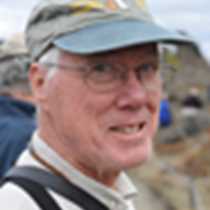South of the Antarctic Circle
The Antarctic Circle: the line on the globe where the sun just fails to set on the longest day of the year, and just fails to rise on the shortest day. Its counterpart in the northern hemisphere, the Arctic Circle, is easily reached. Entire cities lie well above it. Not so in the southern hemisphere. Guarded by sea ice for much of the year, it is seldom reached. But we did. During the night we crossed 66° 33' South latitude, the Antarctic Circle. Glacier-clad mountains surrounded us, bringing their load of ice from the Continent to the sea. It seems fitting that on one of the floating bits of glacial ice stood a solitary emperor penguin. The emperor penguin is to the south as the polar bear is to the north – the iconic figure and symbol of the region. Emperors breed in the depth of the Antarctic winter and then disperse widely, feeding to lay down the deposit of fat that they will need for the next breeding effort. The bird seemed oblivious to our slow and gentle approach. We crowded the foredeck, cameras clicking, for a view that few can ever enjoy.
In mid-morning we reached our destination of Pourquoi-Pas? Island, so named by the French explorer Jean Baptiste Charcot after the expedition ship of his second voyage to Antarctica, 1908-1910. It was the southernmost point of our voyage, at 67° 43' S, seventy nautical miles (80 statute miles) south of the Circle.
As usual, we divided into groups; some to land near a small colony of a few thousand breeding pairs of Adelie penguins, some to cruise by Zodiac to see what they might find. The penguins are nearing the end of their breeding. The young are replacing their brown juvenile down with adult-type feathers of black and white. The last down to be lost is on the top of the head, giving some a very comical punk-rock appearance of a mohawk hairdo.
Those who drew the first Zodiac cruise had a most exceptional experience. The spout of a humpback whale was spotted and the Zodiacs approached. The whale did not move away; in fact, it approached the boats. Something in this whale made it curious, even friendly. As the Zodiacs waited quietly the whale continued its approach until it was only feet away from the gathered boats, and then it made contact, actually pushing a boat with its massive head. All of the tricks and tools of science cannot tell us what goes on in the mind of a whale, or even what it is like for a whale to "think." Was it something in its past experience, perhaps in the wintering area off the Pacific coast of South America, that made this particular whale seek the interaction with humans? We will never know. By the time we returned with the second group of cruisers after lunch our whale had moved on. We saw lots of crabeater seals resting on the ice, but the whale was nowhere to be seen. We cannot initiate such an interaction and we cannot make it continue; it is all up to the whale. We can only rejoice when nature gives us such a moment.




